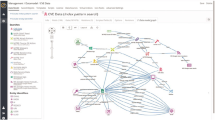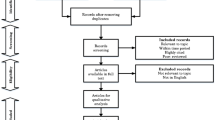Abstract
Building information networks using semantic based techniques to avoid tedious work and to achieve high efficiency has been a long-term goal in the information management world. A great volume of research has focused on developing large scale information networks for general domains to pursue the comprehensiveness and integrity of the information. However, constructing customised information networks containing subject-specific knowledge has been neglected. Such research can potentially return high value in terms of both theoretical and practical contribution. In this paper, a new type of network, solution-oriented information network, is coined that includes research problems and proposed techniques as nodes, and the relationship between them. A lightweight Semantic-based Knowledge Fusion Model (SKFM) is proposed leveraging the power of Natural Language Processing (NLP) and Crowdsourcing to construct the proposed information networks using academic papers (knowledge) from Scopus. SKFM relies on NLP in terms of automatic components while Crowdsourcing is initiated when uncertain cases arise. Applying the NLP technique assists to develop a semi-automatic knowledge fusion method for saving effort and time in extracting information from academic papers. Leveraging human power in uncertain cases is to make sure the essential concepts for developing the information networks are extracted reliably and connected correctly. SKFM shows a theoretical contribution in terms of lightweight knowledge extraction and reconstruction framework, as well as practical value by providing solutions proposed in academic papers to address corresponding research issues in subject-specific areas. Experiments have been implemented which have shown promising results. In the research field of intrusion detection, the information of attack types and proposed solutions has been extracted and integrated in a graphic manner with high accuracy and efficiency.









Similar content being viewed by others
References
Aghaei Chadegani, A., Salehi, H., Yunus, M., Farhadi, H., Fooladi, M., Farhadi, M., & Ale Ebrahim, N. (2013). A comparison between two main academic literature collections. Asian Social Science, 9(5), 18–26.
Baldwin, C., Hughes, J., Hope, T., Jacoby, R., & Ziebland, S. (2003). Ethics and dementia: mapping the literature by bibliometric analysis. International Journal of Geriatric Psychiatry, 18(1), 41–54.
Bao, F., Chen, R., Chang, M., & Cho, J.-H. (2012). Hierarchical trust management for wireless sensor networks and its applications to trust-based routing and intrusion detection. IEEE Transactions on Network and Service Management, 9(2), 169–183.
Bi, B., Szulman, S., & Clement, A. (1999). Terminae: A method and a tool to build a domain ontology. Knowl. Acquis. Model. Manag., 49–66.
Binswanger, M. (2014). Excellence by nonsense: The competition for publications in modern science. In Opening science (pp. 49–72). Springer.
Bisson, G., Nédellec, C., & Canamero, D. (2000). Designing clustering methods for ontology building-the Mo’K workbench. In ECAI workshop on ontology learning (Vol. 31).
Boukerche, A., Machado, R. B., Jucá, K. R., Sobral, J. B. M., & Notare, M. S. (2007). An agent based and biological inspired real-time intrusion detection and security model for computer network operations. Computer Communications, 30(13), 2649–2660.
Boury-Brisset, A. (2001). Towards a knowledge server to support the situation analysis process. In Proceedings of fusion.
Callon, M., Courtial, J. P., & Laville, F. (1991). Co-word analysis as a tool for describing the network of interactions between basic and technological research: The case of polymer chemsitry. Scientometrics, 22(1), 155–205.
Carvalho, R. N., Matsumoto, S., Laskey, K. B., Costa, P. C., Ladeira, M., & Santos, L. L. (2013). Probabilistic ontology and knowledge fusion for procurement fraud detection in brazil. In Uncertainty reasoning for the semantic web ii (pp. 19–40). Springer.
Chaudhary, A., Kumar, A., & Tiwari, V. (2014). A reliable solution against packet dropping attack due to malicious nodes using fuzzy logic in MANETs. In 2014 international conference on optimization, reliabilty, and information technology (ICROIT) (pp. 178–181).
Chiu, W.-T., Huang, J.-S., & Ho, Y.-S. (2004). Bibliometric analysis of severe acute respiratory syndrome-related research in the beginning stage. Scientometrics, 61(1), 69–77.
Chowdhury, G. G. (2010). Introduction to modern information retrieval. Facet Publishing.
Cimiano, P., & Völker, J. (2005). text2onto. In International conference on application of natural language to information systems (pp. 227–238).
Clarke, A., Gatineau, M., Thorogood, M., & Wyn-Roberts, N. (2007). Health promotion research literature in Europe 1995–2005. European Journal of Public Health, 17(Suppl 1), 24–28.
Constantin, A., Pettifer, S., & Voronkov, A. (2013). PDFX: Fully-automated PDF- to-XML conversion of scientific literature. In Proceedings of the 2013 ACM symposium on document engineering (pp. 177–180).
Craven, M., DiPasquo, D., Freitag, D., McCallum, A., Mitchell, T., Nigam, K., et al. (2000). Learning to construct knowledge bases from the world wide web. Artificial Intelligence, 118(1–2), 69–113.
Di Iorio, A., Nuzzolese, A. G., & Peroni, S. (2013). Characterising citations in scholarly documents: The citalo framework. In Extended semantic web conference (pp. 66–77).
Ding, Y., Chowdhury, G. G., & Foo, S. (2001). Bibliometric cartography of information retrieval research by using co-word analysis. Information Processing & Management, 37(6), 817–842.
Dong, X., Gabrilovich, E., Heitz, G., Horn, W., Lao, N., Murphy, K., & Zhang, W. (2014). Knowledge vault: A web-scale approach to probabilistic knowledge fusion. In Proceedings of the 20th ACM SIGKDD international conference on knowledge discovery and data mining (pp. 601–610).
Dumais, S., Banko, M., Brill, E., Lin, J., & Ng, A. (2002). Web question answering: Is more always better? In Proceedings of the 25th annual international ACM SIGIR conference on research and development in information retrieval (pp. 291–298).
Faure, D., & Nédellec, C. (1998). A corpus-based conceptual clustering method for verb frames and ontology acquisition. In LREC workshop on adapting lexical and corpus resources to sublanguages and applications (Vol. 707, p. 30).
Gangemi, A., Draicchio, F., Presutti, V., Nuzzolese, A. G., & Reforgiato, D. (2013). A machine reader for the semantic web. In Proceedings of the 12th international semantic web conference (posters & demonstrations track)-volume 1035 (pp. 149–152).
Guzman-Arenas, A., & Cuevas, A.-D. (2010). Knowledge accumulation through automatic merging of ontologies. Expert Systems with Applications, 37(3), 1991–2005.
Holsapple, C. W., & Whinston, A. B. (1986). Building blocks for decision support systems. In G. Ariav & J. Clifford (Eds.), New directions for database systems (pp. 66–86). Norwood: Ablex Publishing Corp.
Jiang, X., & Tan, A.-H. (2010). CRCTOL: A semantic-based domain ontology learning system. Journal of the Association for Information Science and Technology, 61(1), 150–168.
Kajikawa, Y., & Takeda, Y. (2009). Citation network analysis of organic LEDs. Technological Forecasting and Social Change, 76(8), 1115–1123.
Kajikawa, Y., Yoshikawa, J., Takeda, Y., & Matsushima, K. (2008). Tracking emerging technologies in energy research: Toward a roadmap for sustainable energy. Technological Forecasting and Social Change, 75(6), 771–782.
Kostoff, R. N., Briggs, M. B., Solka, J. L., & Rushenberg, R. L. (2008). Literature-related discovery (LRD): Methodology. Technological Forecasting and Social Change, 75(2), 186–202.
Kuo, T.-T., Tseng, S.-S., & Lin, Y.-T. (2003). Ontology-based knowledge fusion framework using graph partitioning. In International conference on industrial, engineering and other applications of applied intelligent systems (pp. 11–20).
Laskey, K. B., Costa, P. C., & Janssen, T. (2008). Probabilistic ontologies for knowledge fusion. In 2008 11th international conference on information fusion (pp. 1–8).
Levy, A. (1998). The information manifold approach to data integration. IEEE Intelligent Systems, 13(5), 12–16.
Liu, X., Zhang, L., & Hong, S. (2011). Global biodiversity research during 1900–2009: A bibliometric analysis. Biodiversity and Conservation, 20(4), 807–826.
Maedche, A., & Staab, S. (2000). Mining ontologies from text. In International conference on knowledge engineering and knowledge management (pp. 189–202).
Masters, J. (2002). Structured knowledge source integration and its applications to information fusion. In 2002 proceedings of the fifth international conference on information fusion (Vol. 2, pp. 1340–1346).
Missikoff, M., Navigli, R., & Velardi, P. (2002). The usable ontology: An environment for building and assessing a domain ontology. In International semantic web conference (pp. 39–53).
Mohi, M., Movaghar, A., & Zadeh, P. M. (2009). A Bayesian game approach for preventing DOS attacks in wireless sensor networks. In WRI international conference on communications and mobile computing, 2009, CMC’09 (Vol. 3, pp. 507–511).
Nengfu, X., Wensheng, W., Xiaorong, Y., & Lihua, J. (2012). Rule-based agricultural knowledge fusion in web information integration. Sensor Letters, 10(1–2), 635–638.
Nikolov, A., Uren, V., & Motta, E. (2007). Knofuss: A comprehensive architecture for knowledge fusion. In Proceedings of the 4th international conference on knowledge capture (pp. 185–186).
Niu, F., Zhang, C., Re, C., & Shavlik, J. (2012). Elementary: Large-scale knowledge-base construction via machine learning and statistical inference. International Journal on Semantic Web and Information Systems (IJSWIS), 8(3), 42–73.
Nuzzolese, A. G., Peroni, S., & Recupero, D. R. (2016). ACM: Article content miner for assessing the quality of scientific output. In Semantic web evaluation challenge (pp. 281–292).
Perez-Arriaga, M. O., Estrada, T., & Abad-Mota, S. (2016). TAO: System for table detection and extraction from PDF documents. In Flairs conference (pp. 591–596).
Phan-Luong, V. (2008). A framework for integrating information sources under lattice structure. Information Fusion, 9(2), 278–292.
Preece, A., Hui, K., Gray, A., Marti, P., Bench-Capon, T., Cui, Z., et al. (2001). Kraft: An agent architecture for knowledge fusion. International journal of cooperative information systems, 10(01n02), 171–195.
Rajaraman, K., & Tan, A.-H. (2003). Mining semantic networks for knowledge discovery. In Third IEEE international conference on data mining, 2003, ICDM 2003 (pp. 633–636).
Sánchez, D., Moreno, A., & Del Vasto-Terrientes, L. (2012). Learning relation axioms from text: An automatic web-based approach. Expert Systems with Applications, 39(5), 5792–5805.
Scherl, R., & Ulery, D. L. (2004). Technologies for army knowledge fusion (Tech. Rep.). Monmouth Univ West Long Branch, NJ.
Shotton, D. (2009). CiTO, the citation typing ontology, and its use for annotation of reference lists and visualization of citation networks. In: Bio-ontologies 2009 special interest group meeting at ISMB.
Small, H. (1973). Co-citation in the scientific literature: A new measure of the relationship between two documents. Journal of the Association for Information Science and Technology, 24(4), 265–269.
Smirnov, A., Pashkin, M., Levashova, T., & Chilov, N. (2005). Fusion-based knowledge logistics for intelligent decision support in network-centric environment. International Journal of General Systems, 34(6), 673–690.
Sun, Y., & Han, J. (2012). Mining heterogeneous information networks: Principles and methodologies. Synthesis Lectures on Data Mining and Knowledge Discovery, 3(2), 1–159.
Tian, Y., Wen, C., & Hong, S. (2008). Global scientific production on gis research by bibliometric analysis from 1997 to 2006. Journal of Informetrics, 2(1), 65–74.
Tkaczyk, D., Szostek, P., Dendek, P. J., Fedoryszak, M., & Bolikowski, L. (2014). Cermine-automatic extraction of metadata and references from scientific literature. In 2014 11th IAPR international workshop on document analysis systems (DAS) (pp. 217–221).
Viedma-Del-Jesus, M. I., Perakakis, P., Muñoz, M. Á., Löpez-Herrera, A. G., & Vila, J. (2011). Sketching the first 45 years of the journal psychophysiology (1964–2008): A co-word-based analysis. Psychophysiology, 48(8), 1029–1036.
Woon, W. L., Henschel, A., & Madnick, S. (2009). A framework for technology forecasting and visualization. In 2009 IIT’09 international conference on innovations in information technology (pp. 155–159).
Xie, N., Cao, C., & Guo, H. (2005). A knowledge fusion model for web information. In Proceedings of the 2005 IEEE/WIC/ACM international conference on web intelligence (pp. 67–72).
Yan, R., Li, G., & Liu, B. (2015). Knowledge fusion based on DS theory and its application on expert system for software fault diagnosis. In Prognostics and system health management conference (PHM), 2015 (pp. 1–5).
Zhang, Y., Saberi, M., & Chang, E. (2017). Semantic-based lightweight ontology learning framework: A case study of intrusion detection ontology. In Proceedings of the international conference on web intelligence (pp. 1171–1177).
Zhuang, E., Chen, G., & Feng, G. (2011). A network model of knowledge accumulation through diffusion and upgrade. Physica A: Statistical Mechanics and its Applications, 390(13), 2582–2592.
Author information
Authors and Affiliations
Corresponding author
Rights and permissions
About this article
Cite this article
Zhang, Y., Saberi, M. & Chang, E. A semantic-based knowledge fusion model for solution-oriented information network development: a case study in intrusion detection field. Scientometrics 117, 857–886 (2018). https://doi.org/10.1007/s11192-018-2904-6
Received:
Published:
Issue Date:
DOI: https://doi.org/10.1007/s11192-018-2904-6








